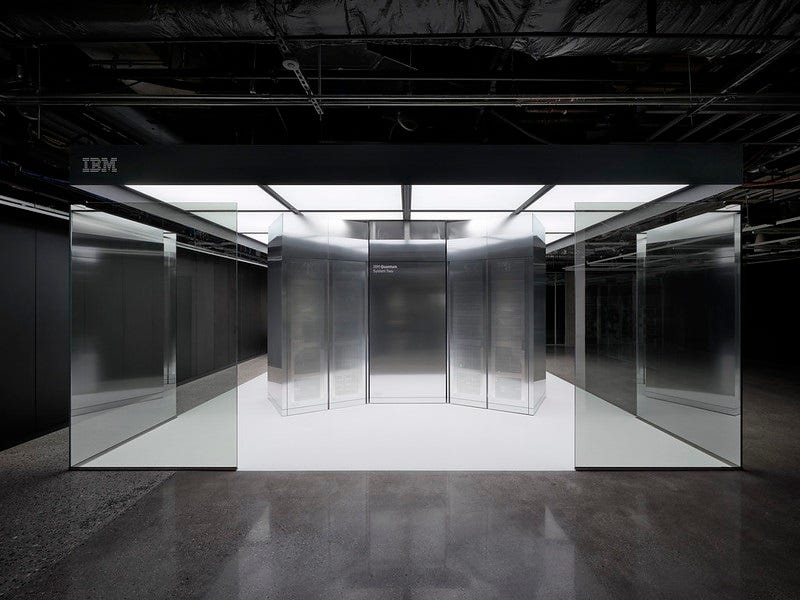Quantum Untangled: Big Blue's Modular Masterplan
IBM has a conference, HSBC protects a trade from quantum hacking, and the Brookings Institution weighs in on quantum education.
What is the best way to make a quantum computer actually capable of solving the big, intractable problems we want quantum computing to solve? “Make it modular,” argues IBM, which debuted its Quantum System Two machine earlier this week. In a video with ambient music conjuring visions of the promo material for Ridley Scott’s Prometheus (or “Look Around You,” depending on your tastes), Big Blue made a clear argument that hooking up multiple quantum processors into a single quantum circuit will deliver the number of logical qubits necessary to finally make quantum computing well and truly practical for scientific researchers and enterprise users.
“Initially powered by three 133-qubit Heron processors, Quantum System Two is fully upgradeable to the growing line of utility-scale QPUs that IBM will be releasing over the next five years,” said IBM. “By the end of 2024, each of the three Heron processors in Quantum System Two will be able to process a remarkable 5,000 operations in a single quantum circuit.”
Linking three processors together doesn’t automatically lead to 399 logical qubits — noise, after all, will render a fair number of those plucky particles entirely useless to science. But IBM also claims to have made significant strides in error correction for its Heron processor, advances which should make it easier to link more of them together in larger and larger quantum circuits. “Continuing down this path,” says our ambient narrator, “we plan to realise a system capable of running 1 billion operations in a single quantum circuit by 2033.”
There is no doubt that this is all Very Exciting, and sounds like it will boost the number of industry collaborations IBM has been embarking on to explore everything from managing decentralised energy grids to applications in telecommunications. The view among quantum computing analysts generally has been positive, too. Quantum System Two, claimed Global Quantum Intelligence’s André M. König, was “stunning,” with IBM’s announcements — including new improvements to its quantum software Qiskit and the debut of “Condor,” a 1,000+ qubit processor — constituting a “massive step forward for our ecosystem.” Gartner’s Mark Horvath agrees. Condor especially is a “notable achievement,” not least given IBM’s release of its 433-qubit Osprey chip last ear. “If they hold to their roadmap,” he told QU, “even more ambitious machines should appear in the near future.” Others speculated that IBM’s quantum roadmap might even revive VC funding for the sector, which has been lagging of late among global quantum start-ups.
But one quantum entrepreneur who wishes to remain unnamed spotted one potential snag in IBM’s scaling operation: refrigeration. While they agreed that modularity was certainly the future for large-scale quantum computing, a system like Quantum System Two necessarily needs to be kept astronomically cool using dilution refrigerators. These units, they continued, “have a habit of not scaling very nicely at all,” not least because it’s still incredibly hard to create a quantum link between chips sitting in two different fridges. Consequently, “you don’t have infinite cooling power available there, which means you can’t just keep adding more and more chips — even if the chips themselves are somewhat modular.”
To its credit, IBM does seem to have realised this is a problem, having talked about building a massive refrigerator codenamed “Project Goldeneye” for a couple of years now. So far, though, it still seems experimental. “Goldeneye may not be slated for use with any of the IBM Quantum processors we're developing today,” the company wrote in September 2022, “but building it taught us important lessons on how to overcome these challenges” related to scaling. Quantum Untangled will keep readers apprised about how Big Blue intends to solve this incredibly cool problem.
In other news…
HSBC has been experimenting with a QKD-based tool designed to protect financial data from hacking by quantum computers. According to Reuters, which broke the story, the bank used it to protect a trade on its AI Markets platform involving the exchange of $30m into US dollars. The test ran on a BT-built network on Toshiba hardware. “Bringing quantum key distribution to a trading scenario is a real-world example of how this technology… establishes a model for even more use cases to help customers stay secure,” said Simone Severini, general manager for quantum technologies at AWS, which also assisted in the experiment.
An interesting report was released by the Brookings Institution on Tuesday arguing that the march of quantum computing in the US is being hindered by a public perception of the field as “somewhat unapproachable.” A general failure to popularise the field relative to other technological frontiers like AI “may jeopardize human capital, research advancement and the economic potential of quantum computing technology in the US.” One of the solutions? Education, education, education. Recent Congressional proposals for hikes in research funding “must be accompanied by thoughtful and innovative initiatives that elevate public literacy and formal training related to [quantum information science and technology].”
Partner Content
How are emerging digital requirements impacting data centre partner selection? - Tech Monitor
How do we restore trust in the public sector? - The New Statesman
Brands must seek digital fashion solutions - Tech Monitor
The new to direct capital deployment to decarbonise household electrification - Capital Monitor


